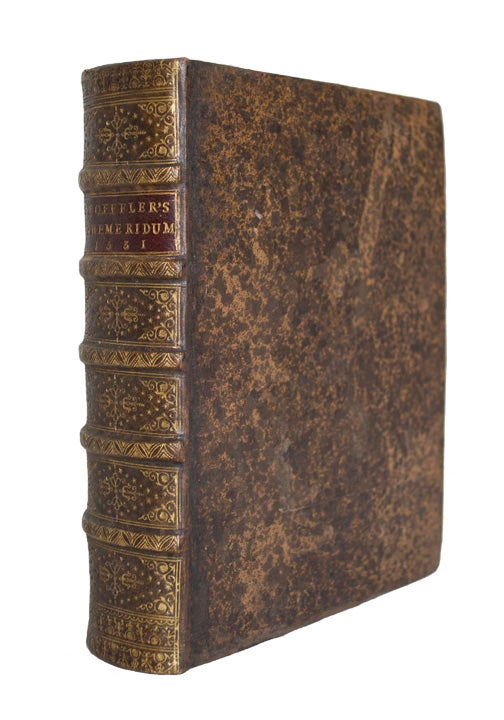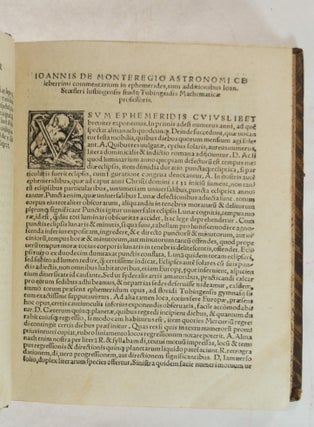First Edition of Stoeffler's Emphemerides
Ephemeridum Opvs Ioannis Stoefleri. Ivstingensis mathe matici à capite anni redemtoris Christi M. D. XXXII. in alios XX. proximè subsequentes, ad ueterum imitationem accuratissimo calculo, elaboratum.
Tübingen: U. Morhart, 1531.
First edition. Quarto (7 5/8 x 6 1/16 inches; 192 x 155 mm). Complete with 318 leaves. Leaf 38 blank as usual. Text in Latin. Title-page with woodcut portrait of Stoeffler, previously mistaken for Copernicus. With three large woodcut initials. With numerous tables and text diagrams throughout.
We could find not other copy at auction in the past fifty years.
Seventeenth-century full mottled calf, rebacked to style. Spine stamped in gilt. Red morocco spine label. All edges speckled red. Newer endpapers. Title-page with some tiny holes, not affecting text. Pages fairly toned throughout. Evidence of a label that has been removed on the front pastedown. Binding is tight and sound. Overall a very good copy.
"[Stoeffler's] were the best ephemerides of the day..." (The Book Nobody Read, Owen Gingerich).
"The name ephemeris or ephemerides is generally reserved for a series of solar, lunar, and planetary positions running over several years. An almanac or calendar runs for a
single year and usually contains ancillary astrological, meteorological, or practical information as well, and in this period the positions printed in most almanacs were simply copied out from some more fundamental ephemeris. Underlying each ephemeris is a set of parameters typically embodied in a group of handy computational
tables, such as the Ptolemaic Alfonsine tables, the Copernican Prutenic tables, or the Keplerian Rudolphlne tables. In the later seventeenth and eighteenth centuries, such tables and related computing procedures proliferated rapidly, as did competing ephemerides, and even more quite highly-derivative almanacs. The first major printed
ephemerides were both calculated and published by Regiomontanus, the astronomer-printer of Nuremberg, in 1474. His calculations ran until 1506, and in due time they were continued by Pfaumen and Stoeffler until 1551. These positions were evidently
based on the Alfonsine tables, for they yield the same characteristic error patterns in
planetary longitudes as the Alfonsines do." (The Accuracy of Ephemerides, Owen Gingerich).
Stoeffler (1452-1531), professor of astronomy at Tübingen University, was one of the first to show how the Julian calendar could be brought into harmony with astronomical events. He did, however, make one absurd prediction—that the Great Flood would occur again in 1524. There was great consternation because of this, and the people of Toulouse even went so far as to build an ark! Stoeffler, however, seems to have survived the failure of his prediction, for he published a new ephemeris in the year of his death.
HBS 67685.
$8,500.
Price: $8,500.00
Item #67685





